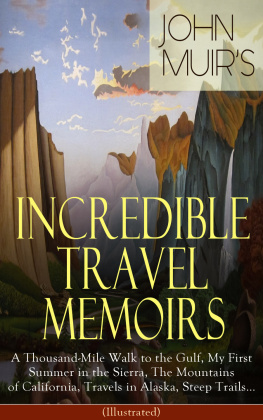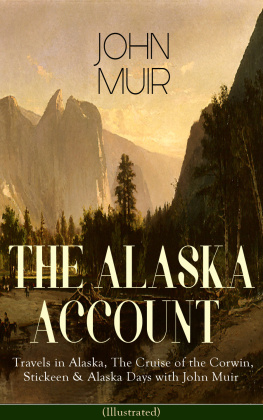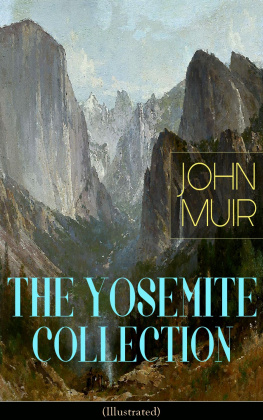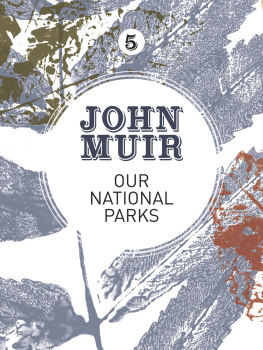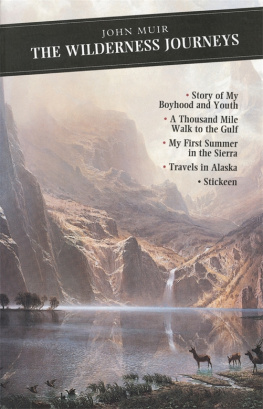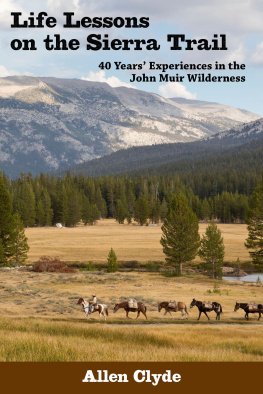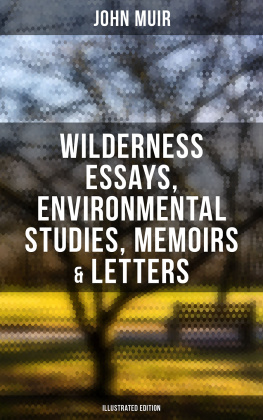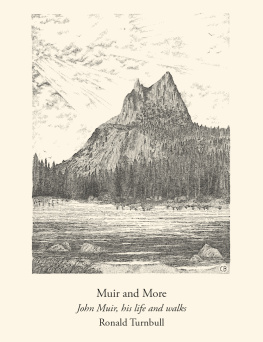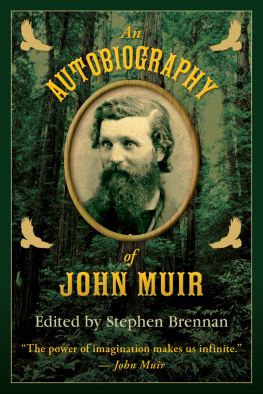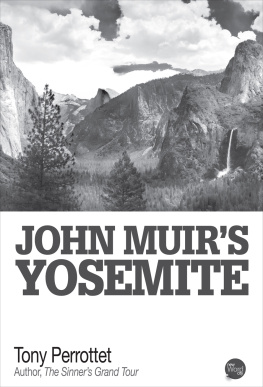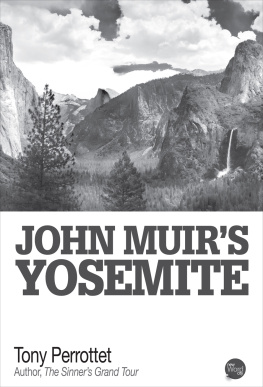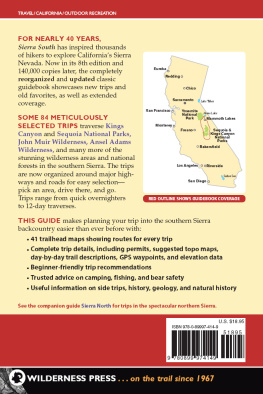First published by Houghton Mifflin Company in 1911.
The text in this volume comes from the 1998 Mariner Books edition.
Muir journal pages courtesy of John Muir Papers, Holt-Atherton Special Collections, University of the Pacific Library. Copyright 1984 Muir-Hanna Trust
For information about permission to reproduce selections from this book, write to or to Permissions, Houghton Mifflin Harcourt Publishing Company, 3 Park Avenue, 19th Floor, New York, New York 10016.
Muir, John, 18381914.
My first summer in the Sierra / by John Muir;
photographs by Scot Miller.
p. cm.
First published by Houghton Mifflin Company in 1911.
Illustrated edition of the American classic.
ISBN : 978-0-618-98851-8
1. Muir, John, 18381914. 2. Natural historySierra Nevada (Calif. and Nev.) 3. Sierra Nevada (Calif. and Nevada) I. Miller, Scot. II. Title.
QH31.M9A3 2012 508.794'4dc22

Upper Yosemite Fall
Foreword
I N THE EARLY summer of 1869, when John Muir left on foot for the high country of Californias Sierra Nevada in the company of 2,050 bleating sheep, he had no idea the journey would utterly transform his life and, in doing so, change the course of our nations history.
Walking great distancesexperiencing his adopted land through the soles of his shoeswas nothing new to Muir. Two years earlier, he had ambled a thousand miles from Indiana to Florida, happily botanizing along the way and keeping a journal in which he had inscribed his name and address as John Muir, Earth-planet, Universe. That walk was to have continued in the wilds of South America, but a bout of malaria caused him to change plans, and in 1868 Muir found himself on the docks of San Francisco with an itch to see a place he had read about in a magazine. It was called Yosemite, nearly 200 more miles away.
So, of course, he walked there: over Pacheco Pass, across Central Valley fields, knee-deep in flowers, through the wooded foothills and into the already-famous valley and its nearby grove of giant sequoias. It was a month of walking for a weeks worth of sightseeing, in a remarkable place that only recently, in 1864, had been set aside by Congress and entrusted to the State of California for protection.
Having spent the wet winter of 186869 cooped up in a dismal little hut near the town of Snelling, reading Shakespeare, Muir was aching to stretch his long legs once more when the seasons changed. Pat Delaney, one of the many mutton barons of the area, planned to move his herd up to the headwaters of the Merced and Tuolumne rivers, fattening them on the alpine meadows of the public domain for the summer, high above the sweltering heat of the Central Valley. He invited Muir to come along, and the Scottish-born wanderer jumped at the chanceeven if by mileage standards this journey would be a mere stroll around the block compared to his two previous epic walks, and even if it meant spending more time with sheep, a species the generally big-hearted Muir was coming to view with increasing disdain.
He accepted because it would permit him to drink in more of the mountains he had tasted only briefly the year before. And he accepted because, at age thirty-one, he was still searching for a direction to his life. What shall I do? Where shall I go? he had asked himself in his journal. Little did he know that Delaneys sheep would lead him to his destiny.
This book is Muirs chronicle of that transformative trip, the greatest of all the months of my life, he wrote, the most truly, divinely free, boundless like eternity, immortal. Published in 1911, more than forty years after the fact, when Muir was in his seventies, it benefits from the older mans perspective, as well as his considerable writing and editing skills, honed over the intervening decades in which he had used the written word to spread his gospel of Nature and become as well known as Yosemite itself. But it is based on the thirty-one-year-olds journal, with all the fresh immediacy and ecstatic emotion of those initial moments of discovery.
Writing, Muir once said, is like the life of a glacier, one eternal grind. My First Summer in the Sierra , his best and most enduring book, extends the analogy. Just as the unforgettable granite domes of Yosemite, so impressive, impassive, and seemingly impermeable, were molded and shaped by patient glaciation, each journal entry here has been sculpted and polished by the man who considered glaciers proof of Nature as a poet, an enthusiastic workingman.
Everything in Nature called destruction must be a creation, a change from beauty to beauty, Muir advises us in these pages, distilling what he learned during his life-changing three and a half months in the Sierra. In the mountains he called the Range of Light, such insights come more easily, he said, because everything is perfectly clean and pure and full of divine lessons... until the hand of God becomes visible.
And the central lesson was a revelation of timeless unitya unity connecting not only all human beings, or even all living things, but the entirety of creation itself: When we try to pick out anything by itself, we find it hitched to everything else in the universe.... The whole wilderness seems to be alive and familiar, full of humanity. The very stones seem talkative, sympathetic, brotherly.
Muirs journal records the date of this revelation as June 6, 1869, only four days into the trip. They had reached an elevation of about 2,500 feet above sea level and made the transition from black oaks to yellow pines. Through an opening in the woods, Muir could see snowy peaks, seemingly within reach and extending an irresistible invitation. Here Muir experienced what he calls a conversion... complete and wholesome:
We are now in the mountains and they are within us, kindling enthusiasm, making every nerve quiver, filling every pore and cell of us. Our flesh-and-bone tabernacle seems transparent as glass to the beauty about us, as if truly an inseparable part of it, thrilling with the air and trees, streams and rocks, in the waves of the suna part of all nature, neither old nor young, sick nor well, but immortal.
Ralph Waldo Emerson and Henry David Thoreau, leaders of American Transcendentalism (and intellectual heroes of Muirs) had expressed a similar creed, but neither of them as profoundly or with such a sense of complete surrender. Muir would reiterate it throughout his summer journal and then preach it for the rest of his life, ultimately inspiring millions of Americans to consider the bounteous continent they inhabited as something sacred, something to treasure and preserve rather than commercialize and exploit.
Everything Muir believed, everything that defined him as a person radiates from these pages. We meet both the wide-eyed youngster in the throes of first experiences and the wise old man of the mountains (now with an editors pen) refining them with the insights of a lifetime. Muir the mystic is present, but equally so is Muir the scientist.


